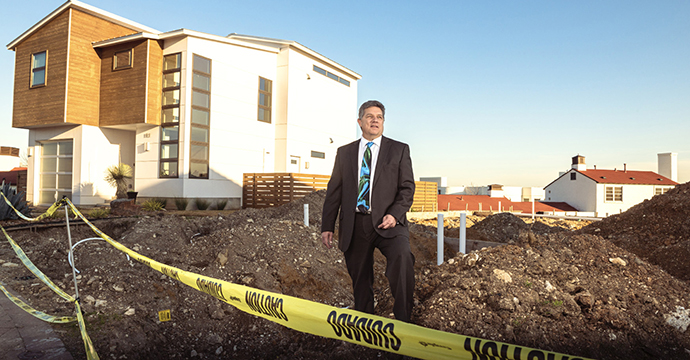Real estate developer Monte Anderson reinvented the Belmont Hotel almost 10 years ago, and he focuses his work on Oak Cliff and southern suburbs — Duncanville, DeSoto and Midlothian. He’s a capitalist, always concerned with the bottom line, but increasingly he is becoming known for responsible development. Anderson is a founding president of the North Texas chapter of the Congress for the New Urbanism. He’s a vocal opponent of the Trinity toll road, Mayor Mike Rawlings and any city councilman whose votes go against what Anderson considers common sense. We asked him a few questions about his ideas for southern Dallas.
Let’s talk about your ideas for responsible urban renewal.
We need owner-occupied entrepreneurs instead of real estate developers. I want other entrepreneurs to be owners. I have my anchors, the Belmont and some other things, but otherwise I’m interested in owner/entrepreneurs; they don’t just rent from me. It’s “gentle-fication”: The real key is that in the early days, the creative business owners would own their building so it doesn’t get gentrified so brutally. We did that in Bishop Arts. How did Bishop Arts grow? How did Jefferson maintain itself all these years? One little business at a time. It has good streetscapes. Jefferson is one of the best streets in Dallas as far as form. It moves people and traffic pretty well.
[quote align=”right” color=”#000000″]It’s “gentle-fication”: The real key is that in the early days, the creative business owners would own their building so it doesn’t get gentrified so brutally. [/quote]
How do you think the city is getting it wrong in southern Dallas?
We’ve tried everything in the world to fix southern Dallas. Walmarts, distribution centers, failed mixed-use by big developers. But what has maintained and survived are little pockets. Davis-Hawn, Wingfield’s, the motorcycle shop on Clarendon. Instead of enhancing what’s already there, [the city thinks] they need to put a big golf course and a five-story mixed-use apartment building, when all you had to do was fix the old gas stations along Beckley. Create streetscapes and on-street parking like we did in Bishop Arts in the early 2000s.
But at least the mayor’s Grow South plan spends money south of the Trinity, right?
I’ve quit believing in large economic development grants. That just breeds corruption and self-interest. And then grants and tax abatements create unnatural development. If you don’t have that, if you don’t have the money, you won’t do these big projects that fail; you’ll do things out of desperation. Maybe you only have the money to put up a tent or a trailer or a small building. The community will grow slower, but it will grow healthier.
The city does have money for economic development, so how should they be spending it?
They should be spending it on rebuilding infrastructure in places that are already doing well. Again, going back to the Community Development Block Grants in Bishop Arts. The sidewalks were bad. There were no street lights. The city ought to be taking money in small amounts and putting it into those types of improvements.
Aside from fixing sidewalks and streetscapes, how else would you spend economic development dollars?
Provide assistance and credit enhancement for entrepreneurs who are willing to go into risky areas, so they could own the property. The city could help guarantee loans in the next edgy area that’s not quite there. North Oak Cliff is going to be fine. Even Elmwood will be fine now. South Oak Cliff and South Dallas are really the question now. There’s probably already a chef in South Dallas who always wanted to open his or her own restaurant. We need to help them get their own building in their neighborhood so that they can inject their own ideas and energy. Owner-occupied entrepreneurs are the key to planning a neighborhood because they become the neighborhood guard. They’re invested, and they care. It’s just like a homeowner neighborhood versus a renter neighborhood. It’s very common-sense.
You’ve been involved with Elmwood. What’s going on there?
I started working with Kenneth Denson and some other people who are very involved in that neighborhood to figure out what they can do and how the [Congress for the New Urbanism] could help. Elmwood was designated a legacy project for CNU 23 [the congress’s annual convention that’s coming to Dallas this spring]. What I like about Elmwood is that if you fix the streetscape — head-in parking, nice sidewalks — then all those parking lots could be one- and two-story buildings.
We often hear that it’s more cost-effective to tear down old buildings and build new. Is that really true, or is it just that builders want to build?
Yeah, it is true. But consider this: What is the real cost of tearing down a building and putting it in the landfill? What is the real cost to our grandkids? Everything we look at in the world of finance, we look at what it does in the next five years. But what does it do in 20 years or 50 years? It cost a lot more to restore the Texas Theatre [Anderson served on the Oak Cliff Foundation, which saved that building from the wrecking ball]. We could’ve torn it down and built a new theater. But we’ve preserved it for the next 100 years. Also, we made it possible for an independent operator to run it and hopefully make money. [The Oak Cliff Foundation, which owns the theater] doesn’t have to make money, so we charge them really cheap rent. It adds to the X factor. It’s the secret sauce. That didn’t come from a development plan; it came from desperation.





